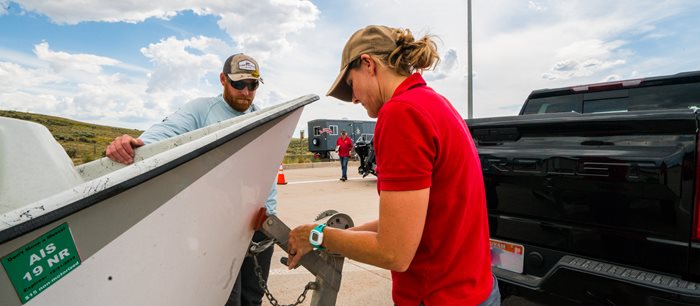AIS watercraft check stations break records for high-risk inspections, decontaminations and mussel boats in 2023

Wyoming once again faced an increased risk from aquatic invasive species in 2023, but remains free of invasive mussels. Over the inspection season, Wyoming Game and Fish Department staff at watercraft check stations inspected more than 73,000 boats across the state to protect the state’s waters from invasive aquatic plants and animals. Game and Fish personnel decontaminated 1,154 watercraft and 64 of those contained mussels — both the highest since the AIS program was established in 2010 by the Wyoming State Legislature.
“This year we saw another increase in high-risk watercraft moving through Wyoming’s check stations,” said Josh Leonard, Game and Fish AIS coordinator. “But that means we’re intercepting the problematic watercraft before they enter Wyoming’s waters.”
AIS check stations are regarded as the first line of defense against invasives entering the state or being spread between Wyoming’s waters. Those range from invasive plants like curly pondweed, which Wyoming does have, to species the state has managed to keep out, like Asian carp and zebra or quagga mussels. Invasive mussels are one of the most destructive types of AIS and it is very unlikely to eradicate mussels once they are established in natural water.
Game and Fish monitors for mussels and other invasives by sampling 20 waters twice per year and an additional 50 waters once per year. One new AIS population was discovered in 2023 — New Zealand mudsnails were found by a member of the public in Alsop Lake in the Laramie Region. This is the first time mudsnails have been detected in the region. Additional populations exist in other areas of the state.
As more states and waters turn up positive for AIS, particularly mussels, the threat to Wyoming continues to grow. The number of high-risk inspections, which are required when a watercraft is suspected of harboring AIS, hit an all time high in 2023 with 7,415 watercraft classified as high-risk. The increase in high-risk inspections, necessary decontaminations and mussel boats could have been influenced by a variety of factors, but the most significant is the increase in mussel detections in states surrounding Wyoming. South Dakota, Nebraska, Colorado, Utah and Idaho all have at least one water containing zebra or quagga mussels.
In Wyoming, the law requires any watercraft transported into the state from March 1- Nov. 30 must undergo a mandatory inspection by an authorized inspector prior to launching. Any watercraft that has been in a water infested with zebra/quagga mussels within the last 30 days is required to undergo a mandatory inspection by an authorized inspector prior to launching during all months of the year. All watercraft must stop at any open watercraft check station on their route of travel, even if not intending to launch in Wyoming.
“So far, Wyoming has been able to withstand the increased threat of invasive mussels,” Leonard said. “Remaining adaptive and utilizing our resources strategically where the threat is highest will help stave off the problem, but more than anything we need each member of the public to do their part. A coordinated effort is how we’ll protect Wyoming’s waters.”




